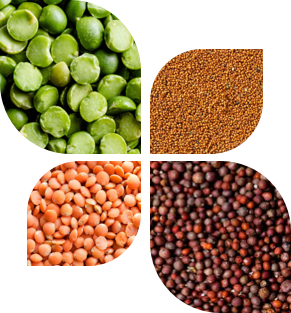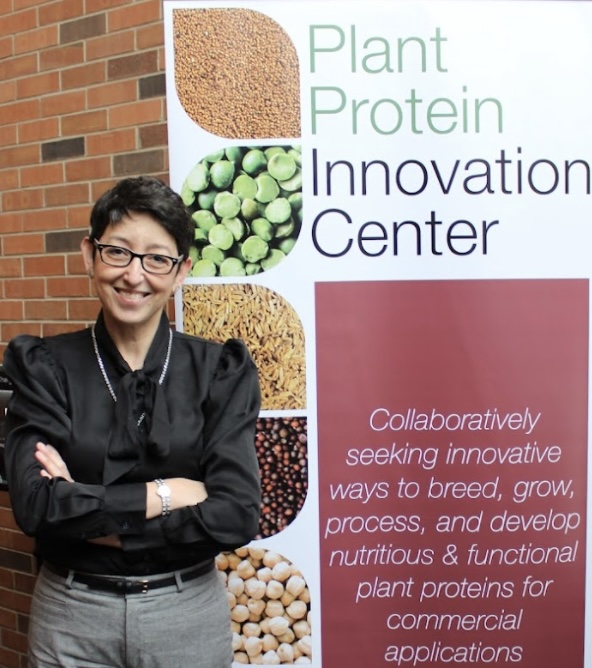
The Plant Protein Innovation Center hosted its First Annual Research Spotlight Meeting on October 17th, 2019 at the University of Minnesota's St. Paul Campus. 105 individuals from 45 companies and organizations attended the event to learn about the novel and most up-to-date research being conducted in the plant proteins space!
The Spotlight Meeting highlighted research conducted by a few individuals from the Center's researcher cohort, including an overview of the research projects funded by the PPIC's first call for proposals! The Spotlight Meeting featured keynote speaker, Julia Keppler from Wageningen University and Research, who gave a talk entitled “Technologies for meat analogues – future challenges.” Attendees engaged in an interactive poster session, held by students of the Center's researchers, and learned more about the Center's members, supporters, and collaborators at their booths. Networking opportunities included a dinner at Axel's Charhouse the night prior, as well as a social hour following the day-long event on the 17th.
The Research Spotlight Meeting will be an annual affair exhibiting the Plant Protein Innovation Center's research progress and prospects. The Center's annual Spring Planning Meeting will re-evaluate research priorities that will influence the overall direction of research -- make sure your voice is heard and attend this Spring event! Date will be announced soon.
Feedback from 2019 Attendees:
"Great event, highlighting the good work of the PPIC in year one."
"I enjoyed the crop breeding to finished product continuum."
"PPIC was able to bring an incredible group together."
"Very well done. Just the right mix of academic research and commercial information."
2019 Research Spotlight Meeting Speakers
Dr. Julia Keppler is currently Assistant Professor in the Laboratory of Food Process Engineering at Wageningen University, Netherlands concentrating on mild protein refining. She received her PhD in food technology from the University of Kiel, Germany in 2013 and was a visiting scientist at INRA, Nantes in France in 2016. She is particularly interested in molecular interactions and modifications of food proteins during processing and storage (e.g. protein interactions with plant polyphenols or sulfur compounds) and the consequences on product or ingredient functionality.
Julia spoke on the following topic at the Research Spotlight Meeting:
"Technologies for meat analogues – future challenges"
There is a growing demand for plant based meat alternatives that mimic the texture and taste of the original to increase consumer acceptance. However, there are still many challenges to be overcome to make the production and processing of plant proteins much more sustainable than animal protein sources. One possibility is the production of so-called functional plant protein extracts with low protein purity, in which fibres and bioactive polyphenols remain in the plant extract. Due to the reduced processing effort, processing time and costs are massively reduced compared to high-purity protein fractions. In fact, due to their unique composition, such less processed extracts seem to be well suited for texturing products with meat-like structures. In the future, the functional as well as the bioactive range of such extracts should be further investigated, in particular the interaction of the different co-extracted fractions during processing. Thus, the functional spectrum of plant based extracts could be extended not only for meat substitutes but also for milk and egg substitutes while simultaneously introducing valuable plant constituents.
B. Pam Ismail, Ph.D., Associate Professor; Director, Plant Protein Innovation Center, Dept. of Food Science and Nutrition, University of Minnesota, 1334 Eckles Avenue, St. Paul, MN 55108
e-mail: [email protected]
Phone: +1 612 625 0147
Dr. Pam Ismail, is an Associate Professor, Department of Food Science and Nutrition, University of Minnesota. Dr. Ismail is the founder and director of the Plant Protein Innovation Center. She has over 20 years of experience in Food Chemistry research focused on analytical chemistry, protein chemistry, and chemistry and fate of bioactive food constituents. Her research focuses on chemical characterization and enhancement of functionality, safety, bioavailability, and bioactivity of food proteins and phytochemicals, following novel processing and analytical approaches. Protein structural characterization is performed using a number of proteomic analytical tools, aiming at linking structure to function. Dr. Ismail has established a collaborative research program focused on developing plant-based protein ingredients, while addressing industry-identified challenges and opportunities, and while seeking sustainable and environmentally friendly sources. Her research has been supported by several funding sources including USDA, Minnesota Department of Agriculture, Midwest Dairy Association, Dairy Research Institute, Healthy Foods Healthy Lives, Forever Green Initiative, General Mills Inc., PepsiCo, and Schwan's, among others. Dr. Ismail teaches a senior undergraduate level Food Analysis course and a graduate level Protein Chemistry course, and is the recipient of several teaching awards including “Distinguished Teaching Award” and an “Outstanding Professor Award”.
Dr. Ismail spoke on "Pea Protein Functionalization: Exploring Cold Plasma"
While pea protein is gaining traction, functionality limitations is hindering its market growth. Improving pea protein functionality will enable its successful utilization in various food products. Cold plasma, a non-thermal processing technique, is being explored as a novel means for protein functionalization. Cold plasma technology involves the exposure of plasma, a partially ionized gas to proteins. The reactive species, generated by cold plasma can induce several chemical reactions including oxidation, bond cleavage, and/or polymerization. This presentation will outline a project designed to evaluate the effect of various cold plasma treatments on pea protein structural and functional properties. Pea protein isolate (PPI) will be subjected to several cold plasma treatment conditions. Reactive species and changes due to potential chemical reactions will be monitored. Specifically, changes in the protein tertiary, secondary and primary structure will be evaluated, and chemical reactions will be elucidated. The impact of structural change on protein functionality will be determined. This research will provide for the first time a controlled evaluation of the impact of cold plasma on pea protein structural and functional characteristics. Cold plasma treatment may lead to the production of a viable pea protein ingredient with functional properties that are comparable or better than those of traditional protein ingredients. The information gathered from this short-term project as well as the joined interdisciplinary effort will definitely lead to designing future long-term studies with a targeted outcome.
Job Ubbink, Professor and Head, Department of Food Science and Nutrition, University of Minnesota
Dr. Ubbink's research focuses on the physical chemistry and materials science of solid and semi-solid food systems, and comprises the study of phase transitions, barrier properties, and rheology of food systems. A specific research interest is the relation between structure and dynamics of the glassy state of bio-based materials as it impacts water uptake, mechanical properties and molecular diffusion. Dr. Ubbink’s research is closely connected to product and process development, covering technology areas such as powder technology, encapsulation, extrusion and freezing. He and his team have worked on dairy powders, including products for infant and clinical nutrition, coffee and beverages, dehydrated culinary products, extruded cereals, baked goods and frozen foods, including ice cream. Research activities in plant proteins include the texturization by extrusion of protein and protein-starch blends and structure-property relations of the extruded products.
Dr. Ubbink was trained as a physical and polymer chemist at the University of Leiden (The Netherlands) and he obtained his PhD in Chemical Technology and Materials Science at Delft University of Technology (The Netherlands). He has worked for over 15 years in R&D positions in the food industry, including 11 years at the Nestlé Research Center (Lausanne, Switzerland). Prior to joining the University of Minnesota, Dr. Ubbink was associated with Cal Poly (San Luis Obispo), the University of Bristol (UK) and the ETH Zurich (Switzerland) and he has taught as visiting professor at the School of Food Engineering, University of Campinas (Brazil).
Dr. Ubbink spoke on the following: "Controlling Carbohydrate and Protein Functionality in the Structuring of High-Solids Foods"
Since several years, the interest in foods based on plant proteins is increasing rapidly. This is driven by several factors, such as concerns about the sustainability of our food, emphasis on a healthy lifestyle and the social acceptance of diets that are largely or fully plant based. Many potential sources of plant proteins, such as algae, are however not palatable in their native state. Others, including many legumes, are gradually losing consumer appeal, because of lengthy preparation times, and because of textures and tastes that are less attractive to today’s consumer. These developments require a technology base that allow for the conversion of the wide range of available plant protein sources into attractive, sustainable and healthy foods. In this lecture, I will discuss how materials science approaches may support the development of such plant protein-based foods, with emphasis on foods in low-moisture states [1]. I will outline how protein and carbohydrate functionality can be exploited to create specific molecular and mesoscopic architectures displaying textures that can be used in for example meat and pasta analogues. Specifically, I will discuss the following cases:
Starch functionality in the optimization of the texture of high-protein foods.
Texturization of food matrices at high and very high viscosities.
Water migration, plasticization and antiplasticization in multiphase food systems in relation to textural changes during shelf life.
MJ Kinney, Food Scientist at the Good Food Institute
MJ is a food scientist with expertise in plant protein applications. She has a multifaceted background in R&D, technical sales, and project management in b2b and b2c industry settings. MJ serves as a technical liaison for plant-forward initiatives – providing guidance in the R&D process, as well as identifying crucial barriers and possible solutions to help propel the industry forward. MJ earned a bachelor’s degree in food science and human nutrition from the University of Florida.
MJ spoke on "High-Value Challenges and Opportunities in Alternative Proteins"
Brief: Data and emerging trends in alternative meat, eggs, and dairy, followed by the white space opportunities in both research and commercialization.
Meat, eggs, and dairy can be made directly from plants or using cellular agriculture. Today’s growing demand for alternative protein products has aligned innovation and markets in a transition toward a sustainable, healthy, and just global food system. However, its success and continued livelihood will undeniably rely on the collaboration of researchers in academic and industry settings. With an eye toward improved taste, price, and convenience, further exploration across crop, raw material, and end-product optimization is essential. GFI’s programmatic departments of SciTech, Corporate Engagement, and Policy, have expertise across the scientific, regulatory, industry, and investment landscape in the U.S., Brazil, India, Europe, Asia Pacific, and Israel. In working with companies across the supply chain and world, GFI serves to share knowledge freely, focus where others are not, and take a big-picture perspective. As a result, we have been able to actively identify and address present-day industry-wide challenges, their opportunities, and aim to forecast and avert future obstacles.
Tom Michaels, Professor, Department of Horticultural Science, University of Minnesota
Tom Michaels studies classical plant breeding and genetics as it applies to food crops. His primary focus is on dry edible bean improvement. His current work targets development of new dry bean cultivars for organic production systems and those growing for local markets such as CSA and food co-ops. Recently he has selected within heirloom bean populations for lines well adapted to upper Midwest US environments. He also directs project improving sweet sorghum (for syrup production), lettuce (for hydroponic production) and industrial hemp.
Dry edible bean is a major protein source in diets around the world and is especially important in food-insecure nations. It is also a crop that, in food-secure nations, is stuck in a culinary rut of canned beans in tomato sauce. Tom is eager to pursue questions about bean protein that will benefit the food-insecure through increased protein quantity and quality, and food-secure through the development of bean protein as an ingredient in exciting and nutritious new foods.
Dr. Michaels spoke on "Seed Protein and Other Stories About Hemp"
Authors: Tom Michaels1, Pam Ismail1 and Jim House2
(1University of Minnesota; 2University of Manitoba)
Industrial hemp for grain has been produced in Minnesota since 2016 under the Industrial Hemp Pilot Program administered by the Minnesota Department of Agriculture. Adjoining states have, or plan, similar pilot programs. The crop is anticipated to expand as a result of new federal regulations stemming from the 2018 Farm Bill, but markets for the crop are key to its long-term success. Hemp seed protein benefits human diets through its high digestibility, potential free radical-scavenging activity and hypoallergenicity. However, hemp protein is considered nutritionally incomplete due to limiting amino acids lysine, leucine and tryptophan. Also, in earlier studies of functional characteristics, hemp protein exhibited poor solubility relative to soybean protein. The Plant Protein Innovation Center, through its first round of interdisciplinary grants, is supporting our work to integrate food science, nutrition and plant genetics toward improvement of hemp seed protein as a food ingredient. The scope of the research involves 1) evaluation and improvement of protein extraction protocols to produce an isolate with acceptable color and flavor and preserved structural characteristics and 2) using this protocol to evaluate differences in seed protein quantity, nutritional quality and structural/functional properties among several grain hemp genotypes. Based on these studies we will develop an interdisciplinary strategy for stimulating use of industrial hemp as a food ingredient through optimized processing protocols, cultivar choice and, if warranted, through plant breeding.
M. David Marks, Professor, Department of Plant and Microbial Biology, University of Minnesota
Development of pennycress and camelina as new cash/cover crops. We are working with the Food Science group at UMN to identify new varieties of the oilseed crops pennycress and camelina. Importantly, these crops have the potential to be grown during the fallow period between the harvest of corn and the establishment of soybeans the following year. Thus, they have the potential to serve as a new source for human nutrition without requiring new farmlands. We will be screening for varieties with improved protein content and quality.
Dr. Marks spoke on "The Potential of Making Eco-Friendly Pennycress into a Premier Source of Protein"
David Marks, Ratan Chopra, and Krishan Mohan Rai
We are in the process of transforming the weed Thlaspi arvense, commonly called pennycress, into a new cash/cover crop. Our greater research team is currently identifying the agronomic practices that will allow pennycress to be grown as a cover crop between traditional summer crops, such as corn and soybean. Currently, corn and soybeans are grown on tens of millions of acres across the Upper Midwest. On average, over 150 pounds of nitrogen per acre are applied to corn to achieve maximum yields. However, even the best varieties of corn use only 50% of this applied fertilizer. The remaining is lost either through the formation of greenhouse gases, in runoff resulting in the pollution of surface waters, or by leaching into groundwaters that serve as the sole source of drinking water for much of the rural Midwest. Growing pennycress as a cover crop after the harvest of corn has been shown to greatly reduce the escape of excess nitrogen fertilizer into the environment. Importantly, pennycress can use this fertilizer to produce seeds high in protein and oil that can be harvested early enough in the spring to allow for a subsequent crop of soybean. This presentation will highlight some of the advances that we have made to remove weedy traits from pennycress that improve its agronomic characteristics and that improve the value of its seeds. Of note, through the use of non-GMO approaches we have created pennycress varieties that produce a canola-like high-oleic oil. Results from ongoing work will be presented that focus on the potential to alter seed protein content as well as to remove undesirable compounds that interfere with protein utilization, isolation, or function.
Adam Franczyk, MSc, PhD Student, Department of Food and Human Nutritional Sciences, University of Manitoba, Winnipeg, MB, Canada
Adam is a PhD student at the University of Manitoba, working under the supervision of Dr. James House. The University of Manitoba is also where Adam completed a Master’s of Science in food and human nutrition in 2018, as well as a bachelor’s of science in cell, molecular and developmental biology in 2016. Adam serves on several committees at the University of Manitoba campus, including the food systems student symposium in 2018 and 2019. He is also coauthor of eight publications within the context of in vitro digestibility and in vitro PDCAAS in plant-based proteins. Currently, Adam is investigating plant-based factors which impact in vitro protein and amino acid digestibility, in an effort to better understand the estimation of in vitro PDCAAS and DIAAS.
Adam spoke on "Innovative Strategies for Evaluating Plant-Based Protein Quality"
Franczyk AJ(1) and House JD(1)
1Department of Food and Human Nutritional Sciences, University of Manitoba, Winnipeg, MB R3T 2N2, Canada
Canada and the US position both protein foods and the increased consumption of plant-based proteins within their national dietary guidelines. Front-of-package labeling through nutrient content claims is one means to position plant-based protein foods to consumers. Substantiation of these claims requires that the item not only have a sufficient quantity of protein, but that it is of a specific quality as well. Meeting these claims in plant-based proteins can prove challenging due to the nature of their limiting amino acids, a reflection that certain plant proteins lack sufficient key amino acids required for normal human growth and metabolism. Several factors are known to influence the quality of plant-based proteins, such as the respective variety, environmental factors, and the effects of processing. Evaluation of protein quality varies by jurisdiction, however, current recommendations from the Food and Agriculture Organization in conjunction with the World Health Organization advocate for the protein digestibility-corrected amino acid score (PDCAAS). To acquire a PDCAAS value, a rat bioassay is needed to measure the extent to which the protein is digested as it passes through the gastrointestinal tract. Innovative methods are needed to replace these rat bioassays, and these could include the use of in vitro digestion models. An assessment of two digestion models, the pH drop (R = 0.91; P ≥ 0.0001) and a pepsin-pancreatin digest (R = 0.92; P ≥ 0.0001) method, indicated strong significant correlations with PDCAAS in 65 plant-based proteins subjected to a variety of processing methods common to human-consumed foods. Development of these models and their validation with in vivo data may decrease the cost and time required for the evaluation of PDCAAS, while simultaneously eliminating ethical issues faced by industries regarding the use of bioassays.
Gary Reineccius, Professor and Past Head, Department of Food Science & Nutrition, University of Minnesota, 1334 Eckles Avenue, St. Paul, MN 55108
Dr. Gary Reineccius has been actively involved in flavor research for more than 47 years. During this time he has published over 230 research articles. His research focuses on two areas: flavor related challenges and ingredient encapsulation. Flavor work has been quite broad covering methods for flavor analysis, off flavor identification and remediation, flavor release in the mouth when eating and its encapsulation (protection and controlled release).
Currently he is conducting three research projects on plant proteins. One project is focused on identifying the chemical components in pea protein isolates that contribute off flavors and the second is similar but targets pennycress protein isolates. Our assumption is that the industry can better design processing techniques to provide bland protein isolates if the offending odorants are known. The third project is focused on improving the stability of flavorings when added to foods containing plant protein isolates. There is evidence that flavor components will form covalent bonds with the sidechains of proteins thereby removing their contribution to flavor perception.
Dr. Reineccius spoke on "Flavor/Protein Issues: Understanding the Problem to Provide Solutions"
Vaidhy Anantharamkrishnan & Gary Reineccius, Department of Food Science and Nutrition, University of Minnesota, St Pail, MN
A major problem in developing new enhanced protein is the challenge of flavoring them. While one can develop flavor formulations that perform in the short time, one cannot develop flavorings that perform in shelf-life. The problem is that proteins are very reactive with many flavoring components - they form covalent bonds with the side chains on the protein. This presentation is going to outline a method of monitoring these types of reactions and then present data on the variables that control the reactions. The ultimate goal is to find a means to preserve flavor by reducing these reactions.








